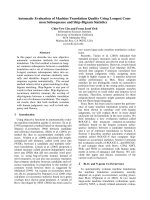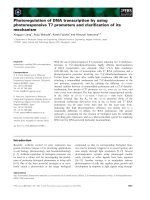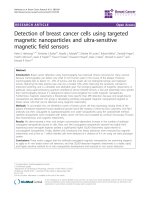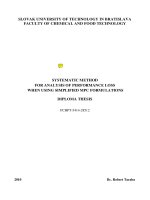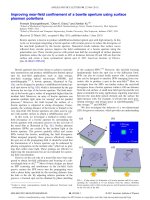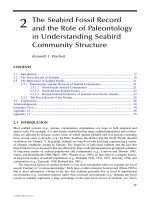Authentication of edible birds nest using advanced analytical techniques and multivariate data analysis
Bạn đang xem bản rút gọn của tài liệu. Xem và tải ngay bản đầy đủ của tài liệu tại đây (6.19 MB, 281 trang )
AUTHENTICATION OF EDIBLE BIRD’S NEST USING
ADVANCED ANALYTICAL TECHNIQUES AND
MULTIVARIATE DATA ANALYSIS
CHUA YONG GUAN PETER
(B.Sc.(Hons.), NUS)
A THESIS SUBMITTED
FOR THE DEGREE OF DOCTOR OF PHILOSOPHY
DEPARMENT OF CHEMISTRY
NATIONAL UNIVERSITY OF SINGAPORE
2014
DECLARATION
I hereby declare that this thesis is my original work and it has been written by
me in its entirety, under the supervision of Professor Li Fong Yau Sam, (in the
laboratory S5-02-05), Chemistry Department, National University of
Singapore between 03-08-2013 and 10-03-2014.
I have duly acknowledged all the sources of information which have been used
in the thesis.
This thesis has not been submitted for any degree in any university previously.
The content of the thesis has been partly published in:
1) Metabolite profiling of edible bird nest using GCMS and LCMS Chua,
Y.G., Bloodworth, B.C., Leong, L.P. and Li, F.Y.S, Journal of Mass
Spectrometry, 2014, 28,1-14.
Chua Yong Guan Peter 10/03/2014
Name Signature Date
ACKNOWLEDGEMENT
I
ACKNOWLEDGEMENT
First, I would like to express my grateful appreciation to my Ph.D supervisor
Professor Li Fong Yau Sam and co-supervisor Dr Leong Lai Peng for their
support in my Ph.D program in the last 5 years. Prof Li has taught me skills of
designing and performing scientific research work that are of the highest
quality. In addition, he has provided me with encouragement and sound
advice whenever I needed them. I am also grateful to Dr Leong who often
took time off from her busy schedule to discuss with me on my research work.
Through these discussions, I was able to obtain useful scientific advice and
knowledge which greatly aids in my understanding on the field of food
authentication.
I would also like to express my gratitude to National University of Singapore
(NUS) and Singapore-Peking-Oxford Research Enterprise for Water Eco-
efficiency (SPORE) for providing me with the research scholarship for my
PH.D studies and all the staff from the Chemistry Department in NUS for the
administrative support. Next, I would like to thank Applied Sciences Group at
the Health Science Authority (HSA) and Shimadzu (Asia Pacific) Pte Ltd for
providing me with the chance of conducting my research work in their
laboratories and Eu Yan Seng (Singapore) for agreeing to sponsor the edible
Throughout the course of my PH.D , it has been a great pleasure to work with
the post-laboratory - Dr Fang Guihua, Dr Ji kaili, Dr
ACKNOWLEDGEMENT
II
Jon Ashely, Mr Ang Jin Qiang, Ms Anna Karen Carrasco, Mr Chen Baisheng,
Ms Lee Si Ni, Mr Lin Xuanhao, Mr Peh En Kai Alister and Ms Zhang Wenlin.
Without them, I am certain that that my research work would not have
proceeded so smoothly. I am grateful to all their assistance and wish them the
best of luck in the future. Also, I would like to thank Professor Bosco Chen
Bloodworth and Ms Joanne Chan from HSA for their assistance in obtaining
the edible bird nest from Malaysia and their advice on the research work. In
addition, I wish to express my thanks to Dr Zhan Zhaoqi, Ms Hui-Loo Lai
Chin, Ms Cynthia Lahey, Mr Ling Gee Siang and Ms Zeng Peiting from
Shimadzu for their valuable technical advice and training in the analytical
instruments. Special thanks are given to Bay Lianjie and Kee Jiahui for
proofreading my thesis.
Last but not least, I am always grateful to my family members and friends for
their continuous support and understanding throughout the journey of my
Ph.D .
Chua Yong Guan Peter
National University of Singapore
March 2014
TABLE OF CONTENTS
III
TABLE OF CONTENTS
ACKNOWLEDGEMENT I
TABLE OF CONTENTS III
SUMMARY VIII
LIST OF TABLES IX
LIST OF FIGURES XI
LIST OF ABBREVIATIONS XVII
LIST OF SYMBOLS XX
CHAPTER 1. INTRODUCTION AND LITERATURE REVIEW 1
1.1. Overview on food authentication 3
1.1.1. Identification of food items 5
1.1.2. Classification of food items 6
1.1.3. Discrimination of genuine food items from its spiked form 8
1.2. Background information on EBN 10
1.2.1. Origin of EBN 10
1.2.2. Production sites of EBN 13
1.2.3. Methods utilized to process the EBN 16
1.2.4. Economic importance of EBN 18
1.2.5. Health effects of the consumption of EBN 18
1.3. Analytical techniques applied for food authentication 21
1.3.1. Deoxyribonucleic acid based techniques 21
TABLE OF CONTENTS
IV
1.3.2. Spectroscopic techniques 23
1.3.3. Chromatographic techniques 24
1.4. Multivariate data analysis 28
1.4.1. Scaling 30
1.4.2. Unsupervised model 32
1.4.3. Supervised model 34
1.5. Scope of thesis 40
CHAPTER 2. IDENTIFICATION OF EDIBLE BIRD’S NEST WITH
AMINO ACIDS AND MONOSACCHARIDES 42
2.1. Introduction 42
2.2. Materials and methods 46
2.2.1. Information on the samples 46
2.2.2. Chemicals and materials 47
2.2.3. Amino acid analysis 48
2.2.4. Monosaccharide analysis 50
2.2.5. Statistical analysis 52
2.2.5. Hotelling T2 range plot 52
2.3. Results and discussion 54
2.3.1. Development and validation of an analytical method for the
monosaccharide analysis of EBNs 54
2.3.2. Establishing the Hotelling T2 range plot to identify EBN 62
2.3.3. Evaluation of Hotelling T2 range plot with non-EBN 67
TABLE OF CONTENTS
V
2.3.4. Assessment of amino acid and monosaccharide contents of EBN . 72
2.3.5. Quality control of EBN with OPLS-DA 78
2.4. Conclusion 79
CHAPTER 3. CLASSIFICATION OF EDIBLE BIRD’S NEST WITH
METABOLITE FINGERPRINTING 81
3.1. Introduction 81
3.2. Materials and methods 84
3.2.1. Sample information 84
3.2.1. Chemicals and materials 85
3.2.2. Analysis with GC/MS 85
3.2.3. Analysis with LC/MS 86
3.2.4. Pre-processing of GC/MS data 88
3.2.5. Pre-processing of LC/MS data 88
3.2.7. Statistical analysis 90
3.3. Results and discussion 90
3.3.1. Profiling of metabolites using GC/MS 90
3.3.2. Profiling of metabolites using LC/MS 95
3.3.3. Classification of EBNs with PCA 103
3.3.4. Classification of EBN based on color 106
3.3.5. Classification of EBN based on country 110
3.3.6. Classification of EBN based on production site 115
3.4. Conclusion 120
TABLE OF CONTENTS
VI
CHAPTER 4. DISCRIMINATION OF EDIBLE BIRD’S NEST WITH
DIFFERENT ANALTYICAL METHODS AND MUTIVARIATE
ANALYSIS 122
4.1. Introduction 122
4.2. Materials and methods 125
4.2.1. Information on the samples 125
4.2.2. Chemicals and materials 126
4.2.3. Analytical methods 128
4.2.4. Statistical analysis 128
4.3. Results and discussion 129
4.3.1. Determination of normalization approach for the different analye
129
4.3.2. Determination of the scaling method for the qualitative
discrimination of EBNs and spiked samples 141
4.3.3. Determination of the multivariate analytical method for the
qualitative discrimination of EBNs and spiked samples 144
4.3.4. Quantitative discrimination of EBN and spiked samples with PLS
regression 154
4.3.5. Variable importance for the projection (VIP) plot for the spiked
samples 159
4.3.6. Qualitative and quantitative discrimination of EBN and multiple
spiked samples 168
4.4. Conclusion 171
TABLE OF CONTENTS
VII
CHAPTER 5. CONCLUSION AND FUTURE WORK 173
5.1. Conclusion 173
5.2. Future work 176
REFERENCES 177
APPENDICES 208
LIST OF PUBLICATIONS AND MANUSCRIPTS 256
SUMMARY
VIII
SUMMARY
analytical methods are developed and applied in combination with
multivariate data analysis to tackle the problem of authenticity. Hotelling T2
range plot illustrated that it is feasible to identify EBN as well as, to
differentiate matries similar to EBN, thereby resolving the issues of quality
control and species of origin of EBN. Classification of EBN according to its
coloration, country of origin and production site could be done with metabolite
fingerprinting and supervised score plots. Moreover, score plots based on the
data from gas chromatography mass spectrometer demonstrated better
prediction abilities. In qualitative discrimination, principal component analysis
is able to discriminate EBN from spiked samples at the level of 0.5 %. In
quantitative analysis, accurate prediction of spiked sample was shown to
detect as low as 1 % of adulterants.
LIST OF TABLES
IX
LIST OF TABLES
Table 1 Examples of food authentication with the use of GC/MS and LC/MS.
28
Table 2 Examples of food authentication with the different types of
multivariate data analysis. 39
Table 3 Retention time, linearity, limits of quantitation (LOQ) and limits of
detection (LOD) for 7 monosaccharides (n = 6). 59
Table 4 Validation result on amino acid and the monosaccharide analysis of
fetuin (n =6). 61
Table 5 Model performance parameters and prediction ability of Hotelling T2
range plots using different types of scaling methods66
Table 6 Concentration of monosaccharide of EBN and the different types of
food items 77
Table 7 Information on the metabolites analyzed by GC/MS. 92
Table 8 Information on the metabolites analyzed by LC/MS. 97
Table 9 Validation results of the OPLS-DA score plots based on GC/MS data
and LC/MS data. 119
LIST OF TABLES
X
Table 10 Model parameters and detection range results for different
normalizing methods. 140
Table 11 Model parameters and detection range results for different scaling
methods. 143
Table 12 Model parameters and detection range results for different
multivariate methods. 152
Table 13 Statistical values of PLS regression for the quantitative
discrimination between EBN and spiked samples. 158
Table 14 Summary of amino acids with VIP values greater than 1. 162
Table 15 Summary of monosaccharides with VIP values greater than 1 163
Table 16 Summary of metabolites analysed with GC/MS with VIP values
greater than 1 164
Table 17RMSEP for multiple spiked samples. 171
LIST OF FIGURES
XI
LIST OF FIGURES
Figure 1 General workflow for the authentication of EBN in this thesis. 2
Figure 2 Map of EBN locations. Shaded in green are the areas where EBN has
been sighted. 11
Figure 3 A picture of an unprocessed EBN. The dimensions are stated at the
side of the EBN. 12
Figure 4 EBNs of different colorations (A) white (B) orange and (C) red. . 13
Figure 5 A man-made building used as EBN farm in Johor Bahru, Malaysia.
15
Figure 6 Graphical display of the processing method for EBN. (A) soaking of
EBN in water (B) manual removal of the impurities from EBN (C) the moulds
which shape the EBN into a half bowl shape. (D) the oven for the drying of
EBN 17
Figure 7 General configuration of the mass spectrometer for GC and LC. 25
Figure 8 General workflow for a multivariate data analysis. 30
Figure 9 Chromatograms of monosaccharides in a 10000 ppm standard. (A)
LIST OF FIGURES
XII
ribose and
according to section 2.2.2. 56
Figure 10 Proposed MS/MS fragmentation of the protonated molecule of
glucose derivatized with PMP ([M+H]
+
, m/z 511). (A) the fragment of m/z
187 while (B) the fragment of m/z 175. 58
Figure 11 Chromatograms of EBN. (A) the amino acid data - and (B)
monosaccharide data. The amino acids and monosaccharides are labelled
according to section 2.2.2. 63
Figure 12 Hotelling T2 range plot of the model set ( ) and prediction set ( ).
Plot (A) constructed based on amino acid data subjected to uv scaling. Plot (B)
constructed based on monosaccharide data subjected to uv scaling. Both plot
(A) and (B) contain a red line representing the critical value 65
Figure 13 Hotelling T2 range plot of different types of samples. (A) Plot
based on amino acid data. (B) Plot based on monosaccharide data 68
Figure 14 Contribution plots of milk and infant formula. (A) milk and (B)
infant formula from amino acid data. (C) milk and (D) infant formula from
monosaccharide data. 70
LIST OF FIGURES
XIII
Figure 15 Column plots of (A) total EAA and (B) total amino acids of
different types of samples. 74
Figure 16 OPLS-DA score plot for the quality control of EBN. (A) based on
the amino acid data and (B) based on the monosaccharide data. The
highlighted portion for each score plot is display on the bottom left. 79
Figure 17 A typical total ion chromatogram of EBN analysed with GC/MS. 91
Figure 18 A typical total ion chromatogram of EBN analysed with LC/MS. (A)
in ES+ mode and (B) in ES- mode. 95
Figure 19 Proposed MS/MS fragmentation of the sodium adduct molecule of
3-Phenyl-5-ureido-1,2,4-triazole ([M+H]
+
, m/z 226.0688). (A) is the fragment
of m/z 167.0255 while (B) is the fragment of m/z 148.0384. 102
Figure 20 PCA score plots to classify EBNs. Score plots (A) to (C) are based
on GC/MS data while score plots (D) to (F) are based on LC/MS data. (A) is
the classification according to coloration. White EBN ( ); Orange EBN ( );
Red EBN ( ). (B) is the classification according to countries. Malaysian EBN
( ); Indonesian EBN ( ); Thai EBN ( ). (C) is the classification according to
production sites. Farm EBN ( ); Cave EBN ( ). (D), (E), (F) has the type of
classification and representation symbols as (A), (B) and (C) respectively. . 105
LIST OF FIGURES
XIV
Figure 21 OPLS-DA score plot constructed for the classification of EBNs
according to coloration. (A) and (B) represents the OPLS-DA score plots for
the GC/MS data and LC/MS respectively. White EBN ( ); Orange EBN ( );
Red EBN ( ).The loading plots for the GC/MS data and LC/MS data to
classify the EBNs according to their coloration are (C) and (D) respectively.
108
Figure 22 Box and whisker plot of (A) 2-acetamido-2-deoxy--D-
glucopyranose, (B) 2-acetamido-2-deoxy--D-glucopyranose (C) 3-Phenyl-5-
ureido-1,2,4-triazole normalized area in EBN. 109
Figure 23 OPLS-DA score plot constructed for the classification of EBNs
according to countries. (A) and (B) represents the OPLS-DA score plots for
the GC/MS data and LC/MS respectively. Malaysian EBN ( ); Indonesian
EBN ( ); Thai EBN ( ). The loading plots for the GC/MS data and LC/MS
data to classify the EBNs according to their countries are (C) and (D)
respectively. 113
Figure 24 OPLS-DA score plot constructed for the classification of EBNs
according to production sites. (A) and (B) represents the OPLS-DA score plots
for the GC/MS data and LC/MS respectively. Farm EBN ( ); Cave EBN ( ).
The loading plots for the GC/MS data and LC/MS data to classify the EBNs
according to their production sites are (C) and (D) respectively. 116
LIST OF FIGURES
XV
Figure 25 Box and whisker plot of (A) ergosterol and (B)
heptadecasphinganine normalized area in EBN. 118
Figure 26 Display of (A) agar agar, (B) fungus and (C) isinglass. 130
Figure 27 Chromatograms of EBN and its spiked samples based on amino
acid analysis. Chromatogram (A) EBN while chromatogram (B), (C) and (D)
samples spiked with agar agar, fungus and isinglass respectively. 131
Figure 28 Total ion chromatograms of EBN and its spiked samples based on
monosaccharide analysis. Chromatogram (A) EBN while chromatogram (B),
(C) and (D) samples spiked with agar agar, fungus and isinglass respectively.
132
Figure 29 Total ion chromatograms of EBN and its spiked samples based on
metabolite fingerprinting with GC/MS. Chromatogram (A) EBN while
chromatogram (B), (C) and (D) samples spiked with agar agar, fungus and
isinglass respectively. 133
Figure 30 Total ion chromatograms of EBN and its spiked samples based on
metabolite fingerprinting with LC/MS in ES+ mode. Chromatogram (A) EBN
while chromatogram (B), (C) and (D) samples spiked with agar agar, fungus
and isinglass respectively. 134
LIST OF FIGURES
XVI
Figure 31 Total ion chromatograms of EBN and its spiked samples based on
metabolite fingerprinting with LC/MS in ES- mode. Chromatogram (A) EBN
while chromatogram (B), (C) and (D) samples spiked with agar agar, fungus
and isinglass respectively. 135
Figure 32 PCA score plots to distinguish between EBN and spiked samples.
(A) based on amino acid data. (B) based on monosaccharide data. (C) based
on metabolite fingerprinting with GC/MS. (D) based on metabolite
fingerprinting with LC/MS 145
Figure 33
analysis. The spiked samples in each plot containing the following adulterant:
(A) agar agar, (B) fungus and (C) isinglass. 147
Figure 34
monosacchairde analysis. The spiked samples in each plot containing the
following adulterant: (A) agar agar, (B) fungus and (C) isinglass. 148
Figure 35
fingerprinting with GC/MS. The spiked samples in each plot containing the
following adulterant: (A) agar agar, (B) fungus and (C) isinglass. 149
Figure 36
fingerprinting with LC/MS. The spiked samples in each plot containing the
following adulterant: (A) agar agar, (B) fungus and (C) isinglass. 150
LIST OF FIGURES
XVII
Figure 37 PLS regression plots of EBN and spiked samples based on
metabolite fingerprinting with GC/MS. The spiked samples in each plot
containing the following adulterant: (A) agar agar, (B) fungus and (C)
isinglass. 157
Figure 38 (A) Prediction results of multiple spiked samples using PCA score
plot based on metabolite fingerprinting with GC/MS. (B) Loading plot of PCA
score plot based on metabolite fingerprinting with GC/MS. 169
LIST OF ABBREVIATIONS
XVIII
LIST OF ABBREVIATIONS
AVA Agri-Food and Veterinary Authority of Singapore
AAS Atomic absorption spectrometer
ANOVA Analysis of variance
CE Collision energy
CS Constant sum
CXP Collision exit potential
DC Direct current
DP Declustering potential
DNA Deoxyribonucleic acid
DModXPS Distance to model X predicted score
EP Entrance potential
EI Electron impact
EU European Union
EAA Essential amino acid
EBN
ESI Electrospray ionisation
ELISA Enzyme-linked immunosorbent assay
FP Focusing potential
FAO Food and Agricultural Organization
FDA Food and Drug Administration
GC/MS Gas chromatography mass spectrometer
GC-FID Gas chromatography flame ionisation detector
HSA Health Science Authority of Singapore
LIST OF ABBREVIATIONS
XIX
LC Liquid chromatography
IT Ion trap
LOD Limits of detection
LOQ Limits of quantification
LC/MS Liquid chromatography mass spectrometer
ICP-MS Inductively-coupled plasma mass spectrometry
LC/MSMS Liquid chromatography tandem mass spectrometer
m/z Mass to charge ratio
MS Mass spectrometer
MRM Multi reaction monitoring
N.A. Not available
NMR Nuclear magnetic resonance
OPLS-DA Orthogonal projections to latent structures discriminant analysis
PC Principal component
Par Pareto scaling
PCA Principal component analysis
PDO Protected designated or origin
PGI Protected geographical indication
PLS Projections to latent structures
PMP 1-phenyl-3-methyl-5-pyrazolone
PLS-DA Projections to latent structures discriminant analysis
Q
2
Goodness of prediction
R
2
Goodness of fit
Rf Radio frequency
RSD Relative standard deviation
LIST OF ABBREVIATIONS
XX
RMSEE Root mean square error of estimation
RMSEP Root mean square error of prediction
SDS-PAGE Sodium dodecyl sulphate polyacrylamide gel electrophoresis
S.D. Standard deviation
TMS Trimethylsilane
TOF Time of flight
TSG Traditional specialities guaranteed
Uv Unit variance
VIP Variable importance for the projection
WHO World Health Organization
2-DE Two-dimensional electrophoresis
LIST OF SYMBOLS
XXI
LIST OF SYMBOLS
P Loading matrix between X and T
Loading matrix between X and
Loading matrix between X and
C Loading matrix between Y and T
Loading matrix between Y and
m m
th
sample in prediction set
X Matrix of N samples and K variables
Y Matrix of N samples and L variables
A Number of principal components
N Number of samples in X or training set
M Number of samples in prediction set
K Number of variablesin X or training set
YPredPS Predicted Y values from the prediction set
YPred Predicted Y values from the training set
PRESS Predictive residual sum of squares
Predictive score matrix of X
E Residual variance matric of X
F Residual variance matric of Y
T Score matrix of X
t Score on the score plot
SS Sum of square
Scaled X variable
Y orthogonal score matrix
LIST OF SYMBOLS
XXII
YVar Y values from the training set
YVarPS Y values from the prediction set
X variable
X variable average
X variable standard deviatio
CHAPTER 1
1
CHAPTER 1. INTRODUCTION AND LITERATURE REVIEW
The natural food item known as EBN) is defined as
) is a food ingredient secreted from the two
sublingual glands of an Aerodramus genus, or more commonly known as
swiftlet. It is recognized as a delicacy, medicine and an important agricultural
product. Despite its widespread consumption and economic importance,
information on safeguarding quality and safety of EBN is far from being
adequate. This opens up to an immense opportunity for fraud of the food item.
To address this problem, authentication of EBN is required.
Food authentication is the act of verifying a food item to see that it complies
with its labelled description to ensure the quality and safety of the food item.
1
To do so, an approach identification, classificationand discrimination of the
food item and its spiked form, was devised and adopted in this thesis. This
would provide a systematic way of tackling the problem of fraud and also give
way to logical explanations on the inherent difference in EBN. The approach
would require the support from various analytical methods to ensure the
success of authentication. For this reason, it is vital to develop accurate and
precise analytical methods capable of providing reliable data prior to study of
the food item. The use of analytical methods would generate a large data set,
making reasonable deductions difficult. As such, multivariate data analysis
would be employed to reduce the complexity and facilitate the interpretation
of obtained results.
2
A graphical display of the general workflow of this thesis
is illustrated in Figure 1.

